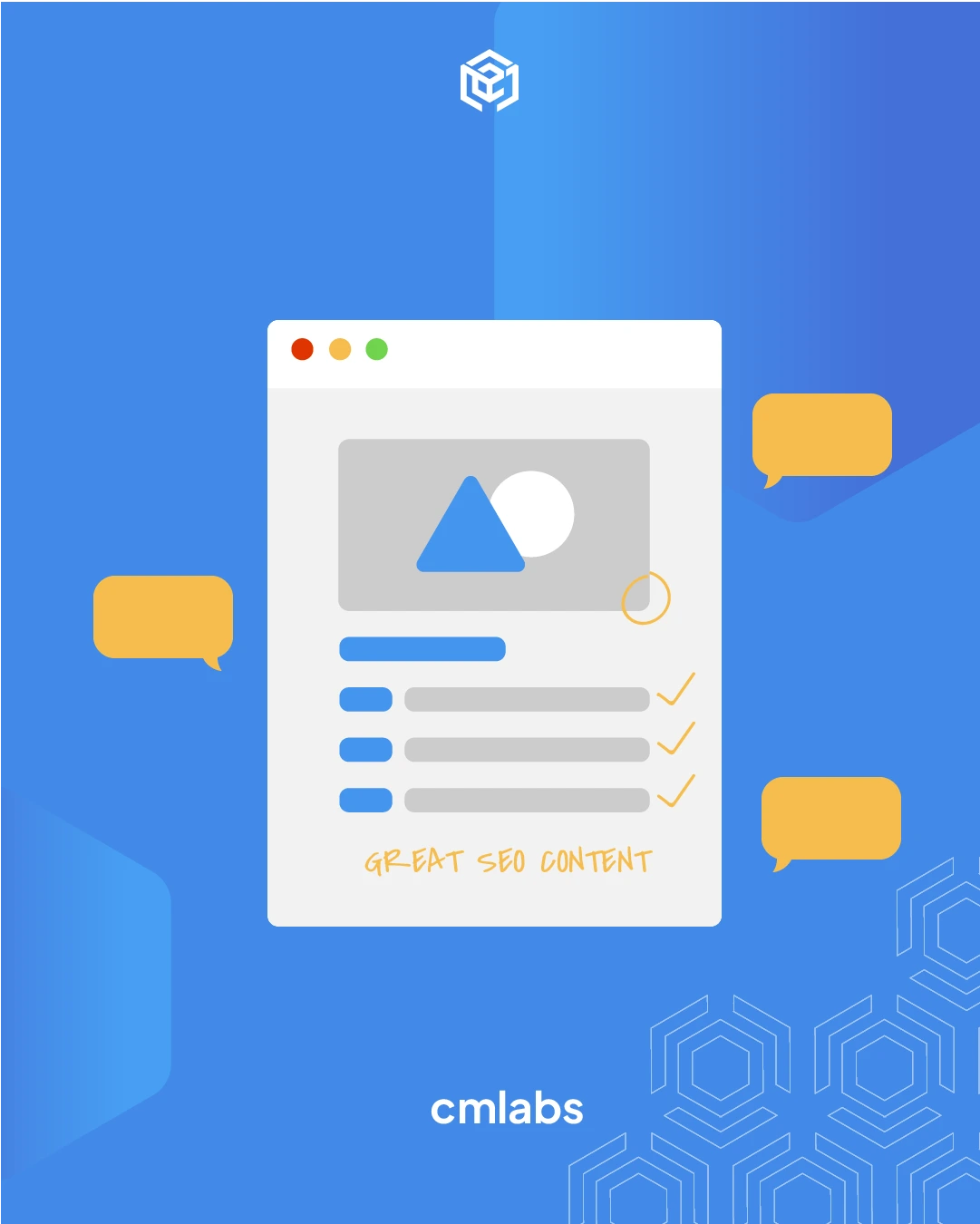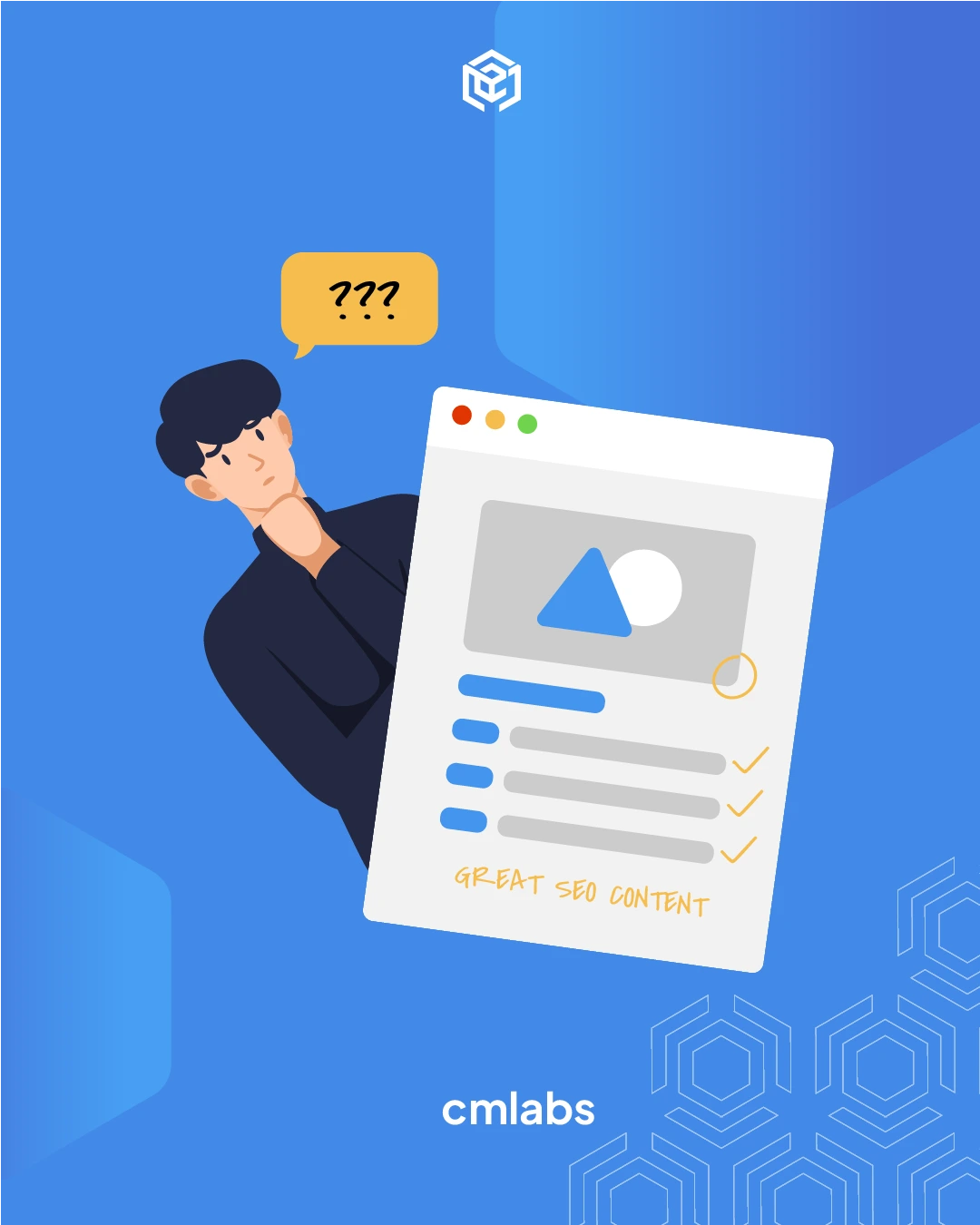We use cookies
This site uses cookies from cmlabs to deliver and enhance the quality of its services and to analyze traffic..
SEO SERVICES
Conduct in-depth technical website audits, strategically develop website projections, and increase your website authority.
ASO SERVICES
Elevate Your App’s Presence with Our Expert ASO Services – Boost Visibility and Drive Downloads!
WRITING SERVICES
We offer a variety of writing services to suit different business necessities. Reach broader audiences or lead specific industries? We've got you covered!
SEOlutions
A unified source of truth!
SEO & Digital Maternity Solution
SEO & Digital Maternity Solution: Leverage Cross-Platform Insights to Elevate Your Strategy with Expert Consultation
SEO & Digital Maternity Solution
Data Solution options:
Starting from Rp200 mio
Reinventing how a company get creative treatments
A new way to get your creative needs done. Agile team, efficient cost, and expedient way in a flexible yet scalable subscription plan!
Creative-as-a-Services
CaaS package options:
Based on Subscription
Pioneer in digital marketing software powerhouse
We’re excited to unveil our new range of Tech Solutions designed to drive your digital success. Whether you’re looking to enhance your website’s performance, streamline your tech stack, or unlock deeper insights from your data, we’ve got you covered.
Starting from Rp250 mio
Our Clients
Research and innovation center for digital transformation
Digital marketing combines technical skills and business knowledge at every stage. For marketing teams, improving budget management efficiency is crucial, as time is an invaluable resource that should be used wisely. At Sequence, we are dedicated to empowering you to optimize efficiency and strategic planning, ultimately enhancing the impact of your digital marketing efforts.
Subscription-based (IDR1,800/keyword)
Our Clients
BeyondSEO
References
SEO Tools for Webmasters
SEO Tools for Writers
SEO Tools
FIND THE SUITABLE PARTNERSHIP FOR YOUR COMPANY
Check out which cmlabs partnership program suits your company
WHITE LABEL SEO
for CorporateYour company is granted exclusive partnership rights to provide SEO services to our important clients, and we will provide a dedicated backend team to support your efforts.
AFFILIATE PROGRAM
for BizdevA new affiliate program is being introduced for skilled marketers and individuals with strong networks, offering commissions of up to 7% for generating profits independently.
DIGITAL AGENCY
for Marketing Partnerscmlabs is an essential partner for digital agencies, providing a unique selling proposition in Search Engine Optimization (SEO).
BACKLINK PARTNERSHIP
for Media / BloggerWe have a vast database of bloggers and media outlets across Indonesia, categorized by region and media type, giving our clients an edge in managing their media and SEO activities.
OFFICIAL TRAINING
We provide ongoing professional development and support to SEO professionals to ensure they are equipped to meet market demands.
JOIN AS CONTRIBUTOR
for Content WriterGreat opportunity for SEO Writers around the world. T&C applied!
ACADEMIC PARTNERSHIP
Through partnerships with universities in Indonesia, cmlabs has helped align academic curricula with industry demands.
Partnership
Sector & Industries
Tell us your SEO needs, our marketing team will help you find the best solution
As an alternative, you can schedule a conference call with our team
Schedule a Meeting?Contact
Survey
We use cookies
This site uses cookies from cmlabs to deliver and enhance the quality of its services and to analyze traffic..
Last updated: Oct 04, 2024
Latent semantic indexing is a search engine algorithm used to understand content relevance based on the words or phrases it contains.
Through the LSI method, search engines can identify key terms that help determine how relevant content is to a user's search query.
LSI works by analyzing the relationship between words in search queries using mathematical operations, enabling search engines to grasp the context and relevant meanings.
Incorporating LSI into your SEO strategy can enrich your content, add value, and provide more detailed information to your target audience.
Ultimately, with LSI, you can also get a bigger chance to rank higher on search engine results pages (SERP).
The main purpose of latent semantic indexing is to help you organize content ideas and structure in a more systematic way, ensuring all aspects are thoroughly covered.
Additionally, incorporating latent semantic indexing in SEO strategy offers several benefits, such as:
When talking about SEO, LSI is a key factor that can significantly impact the success of your content. Proper application will help you create high-quality content, which is a key factor search engines consider when determining rankings.
Here are some steps to effectively implement LSI in your content:
The first step in finding the LSI keyword is to conduct thorough research. In this step, you can start by identifying topics that relate to your niche business and select keywords based on the terms or phrases frequently searched by your audience.
For instance, if you have a business in the pharmaceutical sector and your main topic is "herbal plants," you can enter that primary keyword into Google Keyword Planner and look for other supporting keyword variations.
Tip: Choose keywords with a high search volume but moderate to low competition.
After conducting your research, you can compile your findings into a list of LSI keywords. This list will help you integrate relevant variations of words and phrases into your content, making it more detailed. For example:
Herbal Plants
Benefits of Herbal Plants
Once you have compiled your list of keywords, you can distribute them evenly throughout your content while keeping in mind the keyword’s harmony, relevance, and keyword density.
It is best to prioritize placing keywords in several key areas, such as the title, subtitles, body paragraphs, meta descriptions, and image tags.
However, the types of keywords used should be adjusted based on the context. You can incorporate LSI keywords as variations to avoid being flagged for spam or keyword stuffing.
The next step after incorporating LSI keyword into your content is to optimize its structure. Good content is characterized by a clear layout that is easy for both the audience and search engines to understand.
Therefore, the structure of your content should follow a logical flow of information, using headings and subheadings (H1, H2, and so on) to guide readers through the material.
Using headings breaks information into smaller and more specific sections, which makes it easier for readers to focus on each part.
Additionally, it is important to consider the number of sentences in each paragraph. Ideally, each paragraph should consist of several sentences that are not overly lengthy and convey at least one main idea.
If you have data or statistics, consider presenting them in the form of charts, tables, infographics, or images to make the content more interactive and easier for readers to understand.
Finally, you need to conduct an analysis of the content you have created to assess the effectiveness of the strategies you have implemented.
The impact of using LSI keywords in your content can be measured through metrics such as website traffic, conversion rates, bounce rates, and other indicators relevant to your business needs.
If your analysis shows that your content has declined in performance or has not changed at all, you need to evaluate the situation to identify any errors that may have caused this downturn.
Check out these tips to get the most out of latent semantic indexing (LSI) in your business content:
High-quality content is informative and relevant content, which addresses the problems or needs of your target audience.
Therefore, when creating content, you need to make sure that the information comes from reliable sources, is well-organized, and uses clear, accessible language that aligns with SEO best practices.
Furthermore, you need to also consider proofreading your work before publication to ensure accuracy and consistency.
Another tip for implementing latent semantic indexing is to use keyword variants. There are many SEO myths suggesting that using more primary keywords will lead to better page rankings, but this is not entirely true.
In fact, overusing primary keywords can result in keyword stuffing, which Google may consider as spam.
It is important to keep an eye on keyword density to avoid going overboard. For this purpose, you can take advantage of tools offered by cmlabs, such as a word counter, to check your word count and keyword density.
One common mistake when incorporating LSI keywords into your content is overloading it with too many keywords.
Including keywords without considering their context can create new issues. Hence, it is essential to adjust the placement of keywords and ensure they fit harmoniously within each sentence.
WDYT, you like my article?
Couldn't find result for "Mulki" try to search with different keyword
Suggestion:
Tell us your SEO needs, our marketing team will help you find the best solution
As an alternative, you can schedule a conference call with our team
Schedule a Meeting?



cmlabs Jakarta Jl. Pluit Kencana Raya No.63, Pluit, Penjaringan, Jakarta Utara, DKI Jakarta, 14450, Indonesia
(+62) 21-666-04470These strategic alliances allow us to offer our clients a wider range of SEO innovative solutions and exceptional service.

Psst! Hey there, SEO Stats and Tools SEO company! If you've ever planned of conquering the Germany market, you've come to the right place!